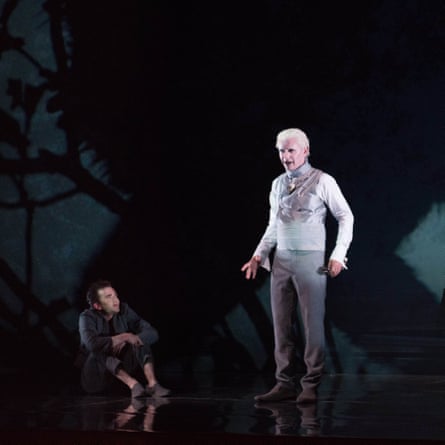The Aldeburgh festival, founded by Benjamin Britten, is almost by definition a purveyor of magical midsummer nights. This was one. Opening the 70th festival, Netia Jones’s new staging of Britten’s A Midsummer Night’s Dream took us into an enchanted Suffolk wood and, with artless simplicity, cast spells.
Jones’s trademark video work might have seemed artificial in this context, but the techno-sophistry encouraged the imagination to take flight, much as Jack Lansbury’s Puck did in his acrobatics. The background to a relatively bare stage offered leafily atmospheric glades, glistening dew and zoom-lens glimpses of the natural world: the bee searching for nectar and a spider weaving complex threads around its hapless victim were perfect metaphors for love’s sweet delight and its bitterness. And the take on the fairies was suitably mischievous: choristers from Chelmsford Cathedral were subverted Artful Dodgers, got up in short-trousered suits with top hats, bleached hair and sunglasses, echoing the bleached and silvery look of Iestyn Davies’s Oberon. His was a fairy king invested with a malevolent stillness, the voice realising an intensity of tone colour to match the magnetic force he exerted on Puck, his serpentine cunning reflected in the image of a slithering snake making for the sleeping Tytania. Sophie Bevan’s fairy queen showed her Queen-of-the-Night vocal flair.

In this celebration of 50 years since the opening of the Snape Maltings Concert Hall, it was an irony that adding a proscenium framework took the edge off the usually perfect acoustic: excepting those of Davies and Matthew Rose, words were too often submerged, together with some of Shakespeare’s wit and Britten’s playfulness. But the old-fashioned charm of the bowler-hatted mechanicals – against their backdrop of cogs and wheels and eventually the fast sweep-hand of time – paid homage to the Maltings’ industrial heritage, while the nonchalant way Rose’s Nick Bottom bicycled on and off was key to his wholly unselfconscious portrayal, itself core to the mechanics of the piece.
Conductor Ryan Wigglesworth had the benefit of very fine singers, with the quartet of lovers sounding glorious and his musicians maximising the lyricism of their solos. Finally, nowhere did the fun that Britten conjured come through more than in the opera-within-an-opera that the tale of Pyramus and Thisbe becomes. Wigglesworth handled that with admirable panache.

Comments (…)
Sign in or create your Guardian account to join the discussion